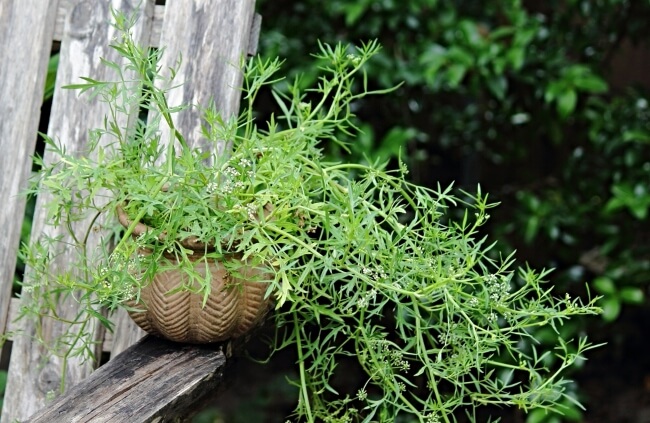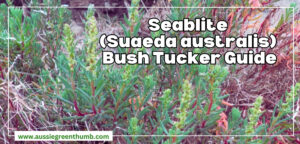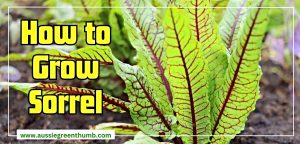Apium prostratum, commonly known as native sea parsley or sea celery is a humble bush tucker plant with a rich history. Eaten by early colonists as one of several foods to prevent scurvy, sea parsley was seen as an essential survival food, providing much-needed edible vegetation..
Now, sea parsley is used to flavour soups, stews and salads and adds a zingy and authentic bush tucker garnish to the best homegrown dishes.
More...
Family: | Apiaceae |
|---|---|
Genus: | Apium |
Species: | A. prostratum |
Common names: | Sea parsley, Sea celery |
Origin: | Australia |
Location: | Outdoor |
Type: | Perennial Herb, Bush Tucker |
Growth: | Height 50 cm x Width 100 cm (up to). |
Sun requirements: | Prefers full sun, tolerates part sun |
Foliage colour: | Green |
Flower colour: | White |
Flowering: | Spring to Summer |
Edible parts: | All |
Maintenance level: | Low |
Poisonous for pets: | Generally considered safe, best to monitor pet consumption due to potential sensitivities. |
What is Sea Parsley?

Source: Gardening With Angus
Native to coastal regions of Australia and New Zealand, sea parsley is a low-growing ground cover herb, with a salty celery and parsley-like flavour. It can also have a peppery aftertaste, a unique difference from its more common relative.
Belonging to the same plant family (Apiaceae) as European parsley (Petroselinum crispum), sea parsley is often used as a culinary alternative as it shares similar flavour profiles.
Although there are two varieties of sea parsley with slight differences in growing habitat, leaf shape and form, both types are used in the same way.
Identifying Sea Parsley
Apium prostratum is given its common name of sea parsley due to its similar-looking leaves. However, this highly adaptive plant varies from place to place in identification traits due to environmental and habitual factors.
Apium prostratum var. prostratum (Headland Sea Parsley)
This is the more prostrate, low-growing variety with broader, flatter serrated leaves. A. prostratum is commonly found growing alongside coastal dunes and headlands.
Apium prostratum var. filiforme (Mangrove Sea Parsley)
This narrower leaf variety has a slightly more erect form but glossier, thicker leaves. Mangrove Sea Parsley grows in wetlands, swaps and lakesides up to tidal stretches of water. Whilst both have very similar flavours, A. filiforme is said to have superior texture and a better plant for culinary uses.
Although both are variable in appearance, both sea parsley varieties can be identified by the distinctive parsley-celery scent when crushing a leaf. Small white clusters or umbels of flowers can be seen from early spring through to late summer.
Common Uses of Sea Parsley
Sea parsley's most common use is culinary, giving flavour and roundness to stocks. Alongside its brilliant health benefits, sea parsley is known to be beneficial to the skin and is often incorporated into homemade beauty products.
It’s a great plant to use if you’re a coastal gardener as it is adaptive, drought tolerant and can be totally submerged by salty tidal water and happily survive.
Storing Sea Parsley
Just like common European parsley, sea parsley can be dried for storage. Dry sea parsley in the same way as other herbs by hanging it in a cool, dry place with good ventilation. Once dry, store leaves in an airtight container.
How to Grow Sea Parsley
Growing this useful herb couldn’t be easier. Although known for its adaptability to certain conditions, if you want the best flavour from your sea parsley, there are some handy tips on how to grow the tastiest crop.


Get Your Free Guide:
Master Growing Australian Natives eBook
A Must Have Complete Guide for Every Australian Garden
Get Your Free Guide:
Master Growing Australian Natives eBook
A Must Have Complete Guide for Every Australian Garden

Source: Kalamunda Plant Company
Soil Conditions & Location
Apium prostratum grows in hostile locations, where the harsh conditions provided by nature actually give sea parsley its unique flavour.
Commonly found growing along coastlines where it can get totally submerged by salty seawater, sea parsley is said to taste of the ocean even more distinctly than some seaweeds, which makes sense given that it derives its flavour profile from it.
If you’re located near the coast with sandy, salty soil, sea parsley will be in its element and provide you with stronger flavoured leaves. This plant grows well in decaying or composted seaweed and sand which give it plenty of organic matter for nutrients.
Adding plenty of compost will help sea parsley continually produce leaves for harvests.
How to Propagate Sea Parsley
Sea parsley will happily self-seed itself under the right conditions (moist, saline, free-draining soil). Typically Apium prostratum is considered to be an annual with semi-perennial tendencies.
This is due to its strong, deep taproot which can enable the plant to come back the following year. Having the deep taproot is what makes sea parsley both able to withstand drought and seawater submergence.
Cuttings are a successful way to propagate sea parsley following the general rules. Simply cut a 10-15 cm section of non-flowering stem, submerge it in water until roots form, or plant directly in moist soil for faster rooting. Once it roots, plant it in its preferred conditions.
Sowing from seed may take several weeks for any germination to be visible but is another viable propagation method. Although not considered to beat risk in the wild, it’s best to obtain seed through a reputable source.
How to Care for Sea Parsley
Give your sea parsley a liquid seaweed feed during the growing season, especially when taking regular harvests. This will ensure fresh, healthy new growth with the best flavour. Leave the leaves a few days after fertilising and thoroughly rinse them before eating.
Common Problems When Growing Sea Parsley
Fungal diseases can be present when sea parsley is either in the wrong location, or if the plant is already struggling and not yet established.
Sea parsley can be prone to sap sucking insects such as aphids. Yellowing leaves with a lack of lustre will be a sign of an infection. Typically these pests will not be detrimental to the plant’s health and can be removed organically with a blast of water.
Start Growing Sea Parsley Today
Sea parsley brings that perfect beach vibe to the table, adding it to sauces to drizzle over salads and barbeque feasts to name a few. It’s a laid back, quality performer perfect for the coastal veggie patch.
Published on October 1, 2024 by Nathan Schwartz
Last Updated on October 2, 2024




